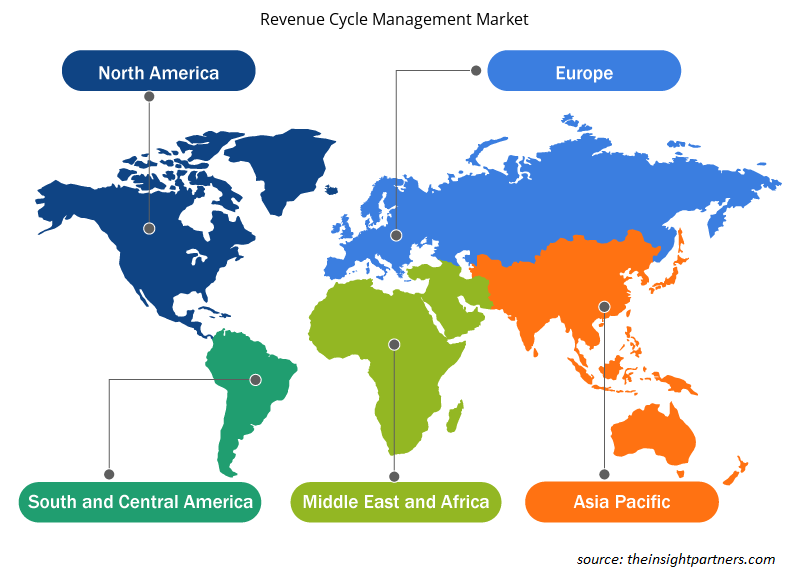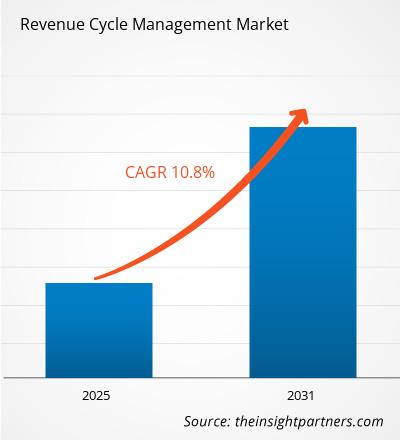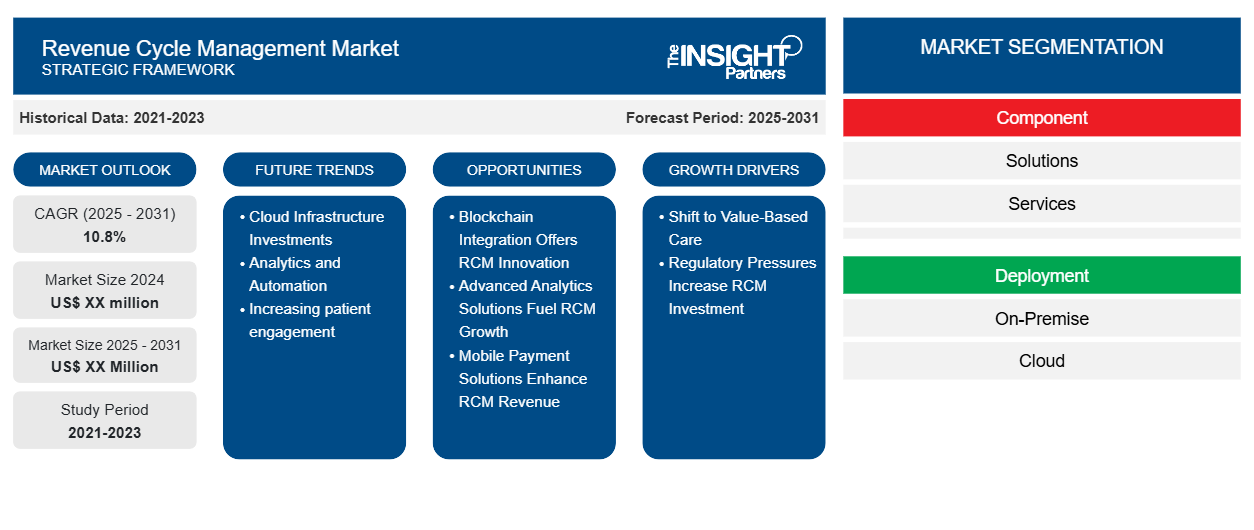[연구보고서] 수익주기관리 시장은 2022년 983억 4천만 달러에서 2031년 2,446억 4천만 달러로 성장할 것으로 예상되며, 2022년부터 2031년까지 연평균 성장률 12.1%로 성장할 것으로 추산됩니다.
분석가 관점:
수익 주기 관리 솔루션 사용을 장려하기 위한 정부 이니셔티브의 증가는 수익 주기 관리 시장 성장을 촉진하는 주요 요인 중 하나입니다. 또한 의료 기관의 청구 오류 및 프로세스 개선으로 인한 수익 손실의 증가는 수익 주기 관리 시장 성장을 촉진하고 있습니다. 의료 청구를 올바르게 처리하는 것은 의료 서비스 제공자의 수익 흐름에 필수적입니다. 의료 시설은 재무 결과를 개선하기 위해 고품질의 보험 청구 및 수익 주기를 계속 유지해야 합니다. 대부분의 의료 서비스 제공자는 청구 거부와 거부된 청구를 제출하거나 연기하지 못하여 돈을 잃고 있으며, 이는 병원에 비용을 절감하라는 압력을 점점 더 가중시키고 있습니다. 이는 시장 참여자에게 수익 주기의 상기 과제를 해결하기 위해 병원을 위한 고급 솔루션을 내놓을 수 있는 기회를 제공했습니다. 또한 수익 주기를 효율적으로 관리하기 위해 시장의 다양한 주요 참여자는 인공 지능(AI) 및 머신 러닝(ML) 기술을 통합하고 있으며, 이는 수익 주기 관리 시장의 성장을 더욱 촉진할 것입니다.
시장 개요:
의료 시설은 의료 청구 소프트웨어를 사용하여 등록 및 약속 예약에서 잔액의 마지막 지불까지 환자 치료 에피소드를 추적하는 재무 프로세스인 수익 주기 관리(RCM)를 활용합니다. 환자 청구 기록을 저장하고 관리하기 위해 의료 서비스 제공자는 종종 수익 주기 관리 시스템에 투자합니다. 환자가 치료 과정을 거치면 효율적인 RCM 시스템은 전자 건강 기록 (EHR) 및 의료 청구 시스템과 같은 다른 의료 IT 시스템에 연결하여 서비스를 수행하고 지불을 받는 사이의 시간을 단축할 수 있습니다. 의료 회사는 RCM 시스템의 도움으로 이전에 직원이 수행했던 작업을 자동화하여 시간을 절약할 수도 있습니다. 관리 작업에는 환자에게 다가올 약속을 알리고, 지불자와 환자에게 미지불 잔액을 상기시키고, 청구가 거부된 경우 특정 문의 사항을 보험사에 문의하는 것이 포함됩니다. RCM 시스템은 또한 제공자에게 청구 거부 이유에 대한 정보를 제공하여 비용을 절감하는 데 도움이 될 수 있습니다. 이를 통해 제공자는 일부 청구가 거부된 이유에 대한 더 나은 통찰력을 얻을 수 있으므로 문제를 해결하고 청구를 다시 제출할 필요가 없습니다.
귀하의 요구 사항에 맞게 이 보고서를 사용자 정의하세요
이 보고서의 일부 또는 국가 수준 분석, Excel 데이터 팩을 포함하여 모든 보고서에 대한 사용자 정의를 무료로 받을 수 있으며 신생 기업 및 대학을 위한 훌륭한 혜택과 할인 혜택을 이용할 수 있습니다.
-
이 보고서의 주요 시장 동향을 알아보세요.이 무료 샘플에는 시장 동향부터 추정 및 예측까지 다양한 데이터 분석이 포함됩니다.
시장 동인:
AI와 ML 기술의 통합은 수익 주기 관리 시장 성장의 기회를 창출합니다.
AI와 ML 기술은 계속해서 추진력을 얻고 수익 관리 시스템 개발에서 잠재력을 입증하고 있습니다 . 많은 조직이 여전히 수동 오류 검사 및 보고서에 의존하여 이상 탐지를 하고 있어 근본 원인을 파악하기 어렵고 시간이 많이 걸리는 프로세스가 되고 있습니다. ML과 AI는 조직이 청구 및 수익 관리 솔루션에서 이상 패턴을 사전에 식별하도록 돕습니다. 또한 이 모델은 정기적인 업데이트로 인해 시간이 지남에 따라 지속적으로 개선되어 정확한 청구와 이상 탐지 자동화가 이루어집니다. AI와 ML은 또한 근본 원인 분석을 가속화하여 조사 시간과 비용을 줄이고 수익 관리 시스템을 사용하여 더 빠른 해결책을 제공할 수 있습니다. 따라서 청구 및 수익 관리 분야의 기술적 발전이 증가함에 따라 예측 기간 동안 수익 주기 관리 시장 성장이 촉진될 가능성이 높습니다.
세그먼트 분석:
구성 요소를 기준으로 수익 주기 관리 시장은 솔루션과 서비스로 세분화됩니다. 솔루션 세그먼트는 2022년 수익 주기 관리 시장에서 가장 큰 점유율을 차지한 반면, 서비스 세그먼트는 예측 기간 동안 수익 주기 관리 시장에서 가장 높은 CAGR을 기록할 것으로 추정됩니다. RCM 소프트웨어는 특히 의료 사기를 방지하고 관리 비용을 줄이기 위해 의료 산업에서 채택이 증가하고 있습니다. 또한 시장의 다양한 주요 업체는 병원, 의료 시설 등에서 수익 주기 관리를 개선하기 위한 고급 솔루션을 제공하기 위해 지속적으로 노력하고 있습니다. 또한 클라우드 기반 RCM에 대한 수요 증가와 전문 서비스에 대한 수요 증가로 인해 서비스 세그먼트가 수익 주기 관리 시장에서 가장 높은 CAGR로 성장할 것으로 예상됩니다.
지역 분석:
북미의 의료 산업은 빠르게 변화하고 있으며, 디지털화로 인해 동기화된 관리 소프트웨어 솔루션을 사용하여 의료 사업의 활동을 구성하고 간소화하는 수익 주기 관리(RCM) 시스템과 같은 의료 IT 서비스를 설치하기가 더 쉬워지고 있습니다. 또한, 의료 부문이 환자 치료를 개선하는 데 점점 더 집중하면서 이 지역의 다양한 시장 참여자가 제공하는 최첨단 혁신적 RCM 솔루션의 재정적 이점과 효과를 활용하면서 시장 성장을 촉진하고 있습니다. 또한, 미국의 의료 부문은 의료비 상승, 평판 좋은 의료 시설 수 증가, 의료 IT 지출 증가, 의료 IT 인프라 개선, 환자-제공자 관계에 대한 강조 증가 등 여러 요인으로 인해 빠르게 확장되고 변화하고 있습니다. 미국 의료보험 및 의료급여 서비스 센터에 따르면, 국가 의료 지출(NHE)은 2021년에 2.7% 증가하여 4조 3,000억 달러(1인당 12,914달러)에 달했으며 GDP의 18.3%를 차지했습니다. 또한, 메디케어 지출은 2021년에 8.4% 증가하여 9,008억 달러에 달했으며, 이는 총 NHE의 21%에 해당합니다. 메디케이드 지출은 2021년에 9.2% 증가하여 7,340억 달러에 달했으며, 이는 총 NHE의 17%에 해당합니다. 미국에서 의료비 지출이 이처럼 증가함에 따라 의료 서비스 제공자는 청구 및 정확한 지불에 있어 복잡한 문제에 직면하고 있으며, 더욱 진보된 RCM 시스템에 대한 필요성이 더욱 커지고 있습니다.
또한, 이 지역의 다양한 시장 참여자들은 지속적으로 고급 솔루션을 제공하기 위해 노력하고 있습니다. 예를 들어, 2023년에 Healthcare Financial Management Association(HFMA)는 의료 수익 주기 관리 소프트웨어 즉 서비스(SaaS) 공급업체인 FinThrive, Inc.와 전략적 제휴를 맺어 의료 시스템이 산업 벤치마크를 활용하여 RCM 기술 성숙도의 현재 상태를 평가하고 수익 주기 결과를 최적화하기 위한 모범 사례 계획을 수립하도록 돕기 위해 설계된 동료 검토를 거친 5단계 수익 주기 관리 기술 도입 모델(RCMTAM)을 공동 출시한다고 발표했습니다. 따라서 위의 모든 요소가 북미의 수익 주기 관리 시장 성장을 촉진하고 있습니다.
주요 플레이어 분석:
Athenahealth Inc., Experian Information Solutions Inc., GE Healthcare, McKesson Corporation, NXGN Management LLC, Optum Inc., Oracle Corporation, R1 RCM Inc., The SSI Group, Veradigm LLC는 주요 수익 주기 관리 시장 참여자 중 일부입니다. 이러한 수익 주기 관리 시장 참여자는 지속적인 제품 개발과 혁신에 집중합니다.
최근 개발 사항:
합병 및 인수와 같은 무기적 및 유기적 전략은 매출 주기 관리 시장에서 회사들에 의해 널리 채택됩니다. 최근 매출 주기 관리 시장 개발 몇 가지가 아래에 나와 있습니다.
- 2023년 10월, Omega Healthcare는 Omega Digital Platform(ODP) 출시를 발표했습니다. 이는 의료 기관이 재무 실적을 개선하는 동시에 행정적 부담을 줄이는 데 도움이 되도록 설계되었습니다. ODP는 고급 독점 기술을 활용하여 워크플로를 간소화하고 재무 실적을 개선합니다. 로봇 프로세스 자동화(RPA), AI 및 ML, 봇, 자연어 처리(NLP)에 대한 심층적인 도메인 및 기술 전문 지식을 활용하여 솔루션이 더 큰 효율성과 정확성을 달성할 수 있도록 합니다.
- 2021년 6월, 선도적인 운영 관리 및 분석 회사인 EXL은 EXL Health 사업부에서 새로운 통합 수익 관리 솔루션을 출시한다고 발표했습니다. EXL Health는 의료 데이터를 실행 가능한 정보로 변환하는 데 전념하는 솔루션 공급업체인 REVELOHEALTH와 협력했습니다. EXL Health와 REVELOHEALTH는 지식과 전문성을 결합하여 포괄적이고 데이터 중심의 지불 처리 및 수익 분석 기능을 제공하는 새로운 솔루션을 제공했습니다. 이 새로운 기능은 공급업체가 수익 주기 관리, 운영 목표 및 규정 준수를 최적화하는 데 도움이 되도록 구성되었습니다.
- 2021년 6월, 선도적인 컨설팅 및 전문 서비스 기관인 Vee Technologies는 Sona Suite 제품과 주력 RCM 워크플로 도구인 Sona PROMISE를 출시한다고 발표했습니다. RCM 솔루션은 운영 워크플로를 개선하고 비즈니스 인텔리전스 기능을 활성화하도록 설계되었으며 병원, 전문 진료소, 의료 진료소, 외래 수술 센터 등을 관리하기 위한 독립형 도구가 될 수 있습니다. 이 솔루션은 비즈니스 운영을 간소화하고 매출과 성장 잠재력을 높이기 위해 고급 비즈니스 분석을 제공하도록 설계되었습니다.
- 2021년 1월, 의료 분야를 위한 선도적인 기술 기반 수익 주기 관리(RCM) 서비스 제공업체인 R1 RCM Inc는 대규모 독립 진료소와 병원 소유 의료 그룹을 위한 새로운 의사 수익 주기 관리 솔루션인 R1 Professional을 출시했습니다. 이 새로운 솔루션은 특수 목적 기술 플랫폼, 대규모 자동화, 소비자 기대에 부합하는 디지털 환자 재무 경험, 대규모 의료 기관 전반에서 재무 가시성을 강화하는 입증된 성과 개선 역량으로 뒷받침됩니다.
보고 범위
수익 주기 관리 시장 지역 통찰력
Insight Partners의 분석가들은 예측 기간 동안 수익 주기 관리 시장에 영향을 미치는 지역적 추세와 요인을 철저히 설명했습니다. 이 섹션에서는 북미, 유럽, 아시아 태평양, 중동 및 아프리카, 남미 및 중미의 수익 주기 관리 시장 세그먼트와 지리적 분포도 논의합니다.

- 수익 주기 관리 시장에 대한 지역별 데이터 얻기
수익 주기 관리 시장 보고서 범위
| 보고서 속성 | 세부 |
|---|---|
| 2023년 시장 규모 | 미화 XX백만 달러 |
| 2031년까지 시장 규모 | 미화 XX 백만 |
| 글로벌 CAGR (2023-2031) | 10.8% |
| 역사적 데이터 | 2021-2022 |
| 예측 기간 | 2024-2031 |
| 다루는 세그먼트 |
구성 요소별로
|
| 포함된 지역 및 국가 |
북아메리카
|
| 시장 선도 기업 및 주요 회사 프로필 |
|
수익 주기 관리 시장 참여자 밀도: 비즈니스 역학에 미치는 영향 이해
수익 사이클 관리 시장 시장은 소비자 선호도의 변화, 기술 발전, 제품의 이점에 대한 인식 증가와 같은 요인으로 인해 최종 사용자 수요가 증가함에 따라 빠르게 성장하고 있습니다. 수요가 증가함에 따라 기업은 제품을 확장하고, 소비자의 요구를 충족하기 위해 혁신하고, 새로운 트렌드를 활용하여 시장 성장을 더욱 촉진하고 있습니다.
시장 참여자 밀도는 특정 시장이나 산업 내에서 운영되는 회사나 기업의 분포를 말합니다. 주어진 시장 공간에 얼마나 많은 경쟁자(시장 참여자)가 존재하는지 그 규모나 전체 시장 가치에 비해 나타냅니다.
수익 주기 관리 시장에서 운영되는 주요 회사는 다음과 같습니다.
- 올스크립트 헬스케어 솔루션 주식회사
- 아테나헬스 주식회사
- 세르너 코퍼레이션
- 에클리니컬웍스, LLC
- 에픽 시스템즈 코퍼레이션
면책 조항 : 위에 나열된 회사는 어떤 특별한 순서에 따라 순위가 매겨지지 않았습니다.

- 수익 주기 관리 시장 주요 주요 업체 개요를 알아보세요
- 과거 분석(2년), 기준 연도, CAGR을 포함한 예측(7년)
- PEST 및 SWOT 분석
- 시장 규모 가치/거래량 - 글로벌, 지역, 국가
- 산업 및 경쟁 환경
- Excel 데이터세트
최근 보고서
관련 보고서
사용 후기
구매 이유
- 정보에 기반한 의사 결정
- 시장 역학 이해
- 경쟁 분석
- 고객 인사이트
- 시장 예측
- 위험 완화
- 전략 기획
- 투자 타당성 분석
- 신흥 시장 파악
- 마케팅 전략 강화
- 운영 효율성 향상
- 규제 동향에 발맞춰 대응























 무료 샘플 받기 - 수익주기 관리 시장
무료 샘플 받기 - 수익주기 관리 시장